In this Jerusalem artichokes recipe, I'll be sharing my favorite way to enjoy these surprisingly sweet and nutty tubers...pickled! There are many sunchoke recipes online, but this is by far my favorite! Torshi, including pickled artichokes, are served on the side with most Assyrian meals!

"Sunchokes" are called "
Sometimes Jerusalem artichokes are hard to digest, but pickling them makes them much easier to digest! So if you have some of these yummy tubers on hand and are wondering what to do with them, try this pickled Jerusalem artichoke recipe!
Jump to:
😍 Why You'll Love This Recipe
- Pickled sunchokes have a way of taking over the garden, so pickling them is a great way of preserving them to enjoy throughout the year.
- Fermented vegetables contain lots of healthy gut bacteria.
- This is an easy-to-follow recipe and only requires a handful of ingredients.
🔖 Ingredient & Substitutions

- Sunchokes - Sunchokes can be found in the Fall in some health food stores or ethnic markets. They can be listed as "Sunflower Chokes" or "Jerusalem artichokes." They can also be grown by sticking the tubers into the ground. Once planted, the tubers spread and multiply in number and can be harvested in the Fall.
- Curry - Curry powder comes in both hot and mild varieties; either may be used in this recipe.
- Vinegar - I like to use a combination of apple cider vinegar and distilled white vinegar. However, you can choose either one.
- Peppers - Spicy peppers like habaneros are not added traditionally, but I like to add them. Feel free to leave them out.

🌻 How to Make This Recipe
Step 1: Thoroughly clean sunchokes to remove all the soil and dirt. Trim any dark spots or knots off, and peel if needed.
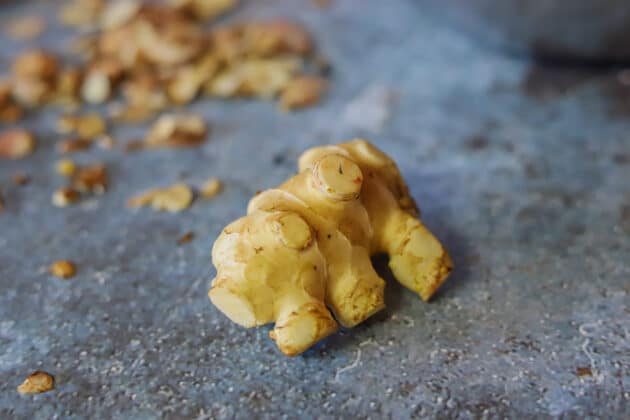
Step 2: Stir half of the salt into one quart (4 cups) of cold water, and mix until the salt is dissolved. Place sunchokes in a large sterilized jar. Cover with the brine solution.
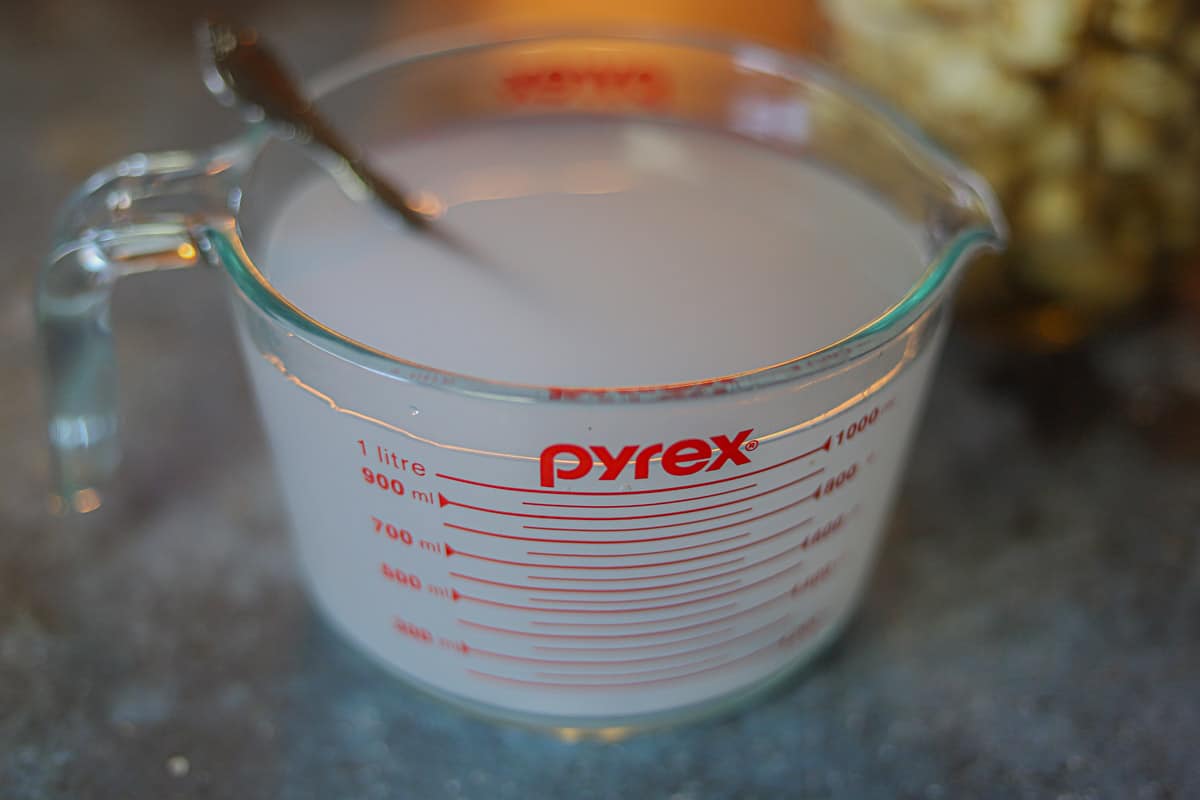
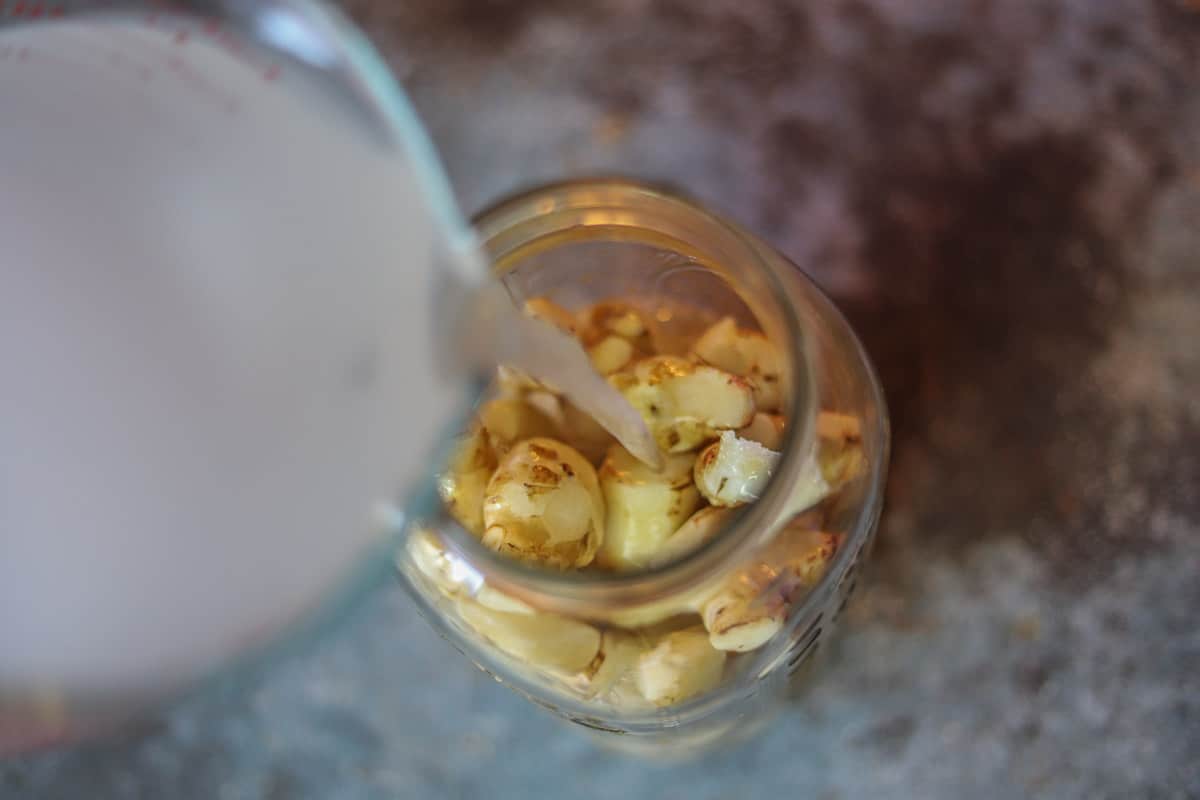
Step 3: Leave the lid untightened to allow the gases to escape. Place the bottle in a dark location for one week.
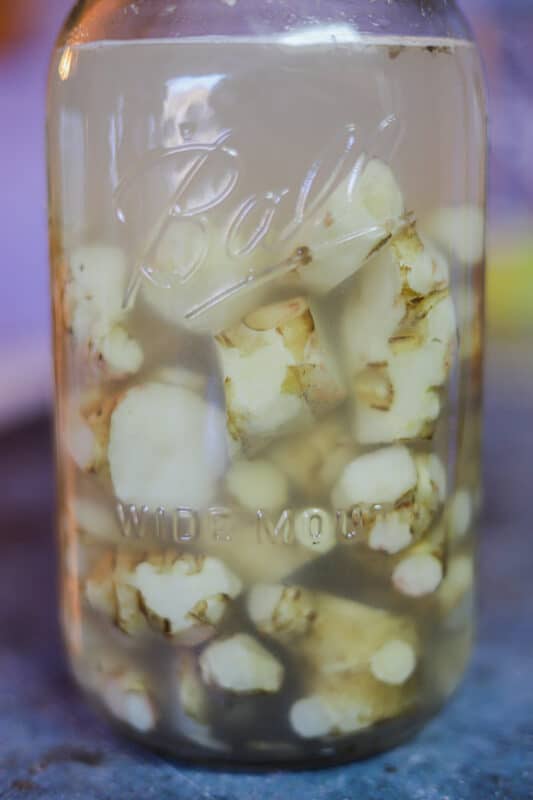
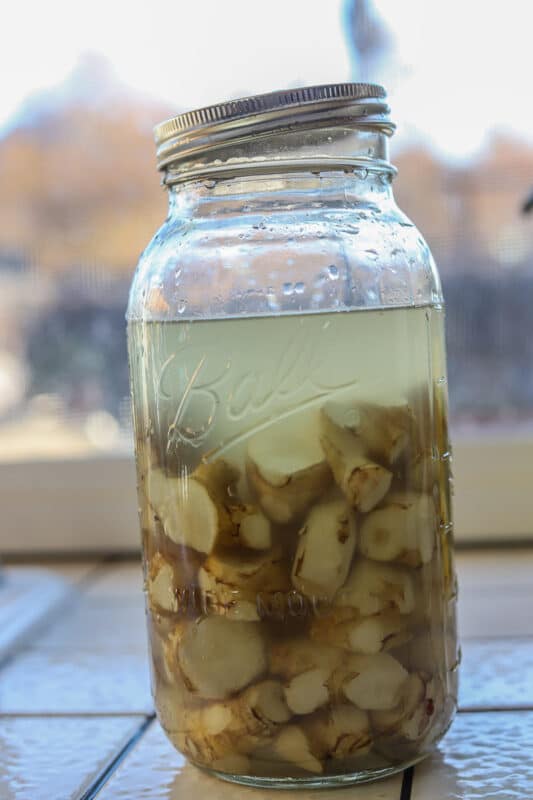
Step 4: Check the bottled sunchokes after three days. There should be a build-up of gases. If not, be patient, it will happen.
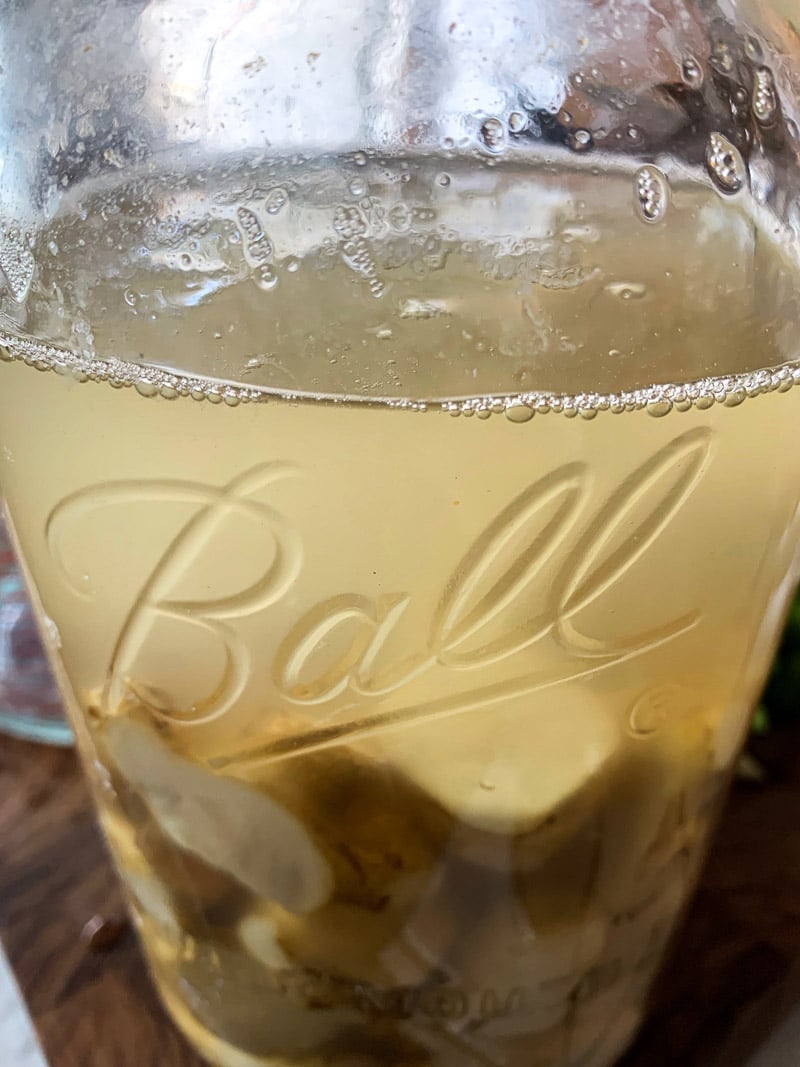
Step 5: When the brine does get murky and the gases float to the surface drain the old brine and make a new batch. Brine the sunchokes for approximately four more days.
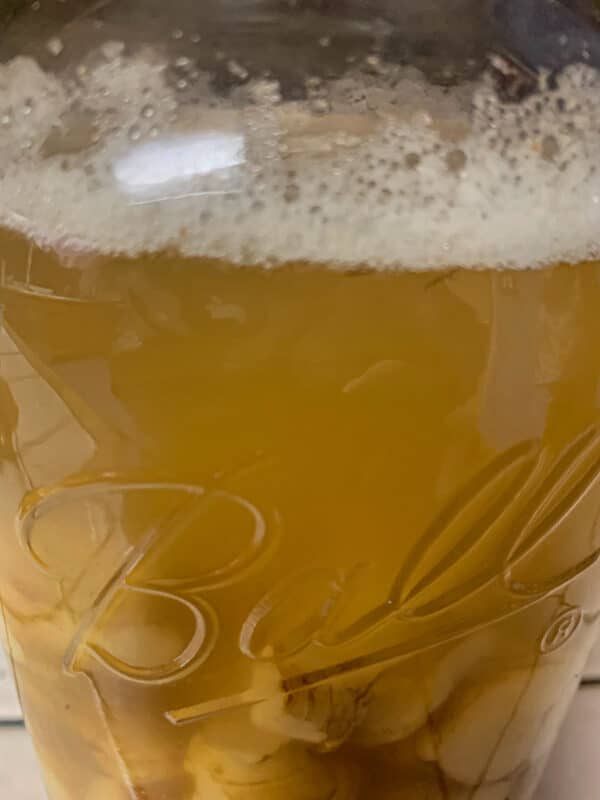
Step 6: Once the sunchokes have been brined for one week, remove them from the brine and rinse them with fresh, cold water.
Would you like to save this recipe?
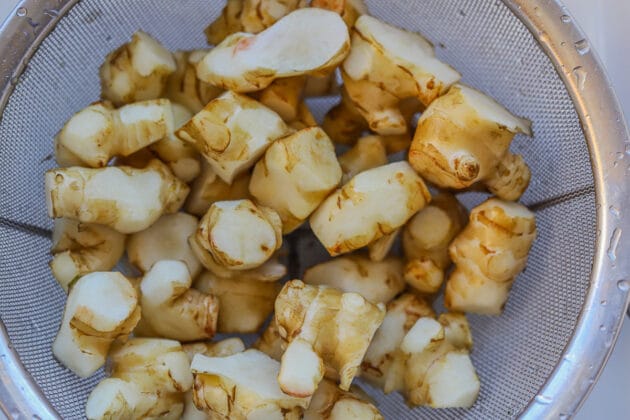
Step 7: Pour vinegar into a saucepan and bring to a boil. Remove from heat and stir the curry into the vinegar until combined. The curry will still settle to the bottom, which is ok.

Step 8: Allow the vinegar to cool for approximately five minutes. Add sunchokes, garlic, parsley, and chilis (if using).
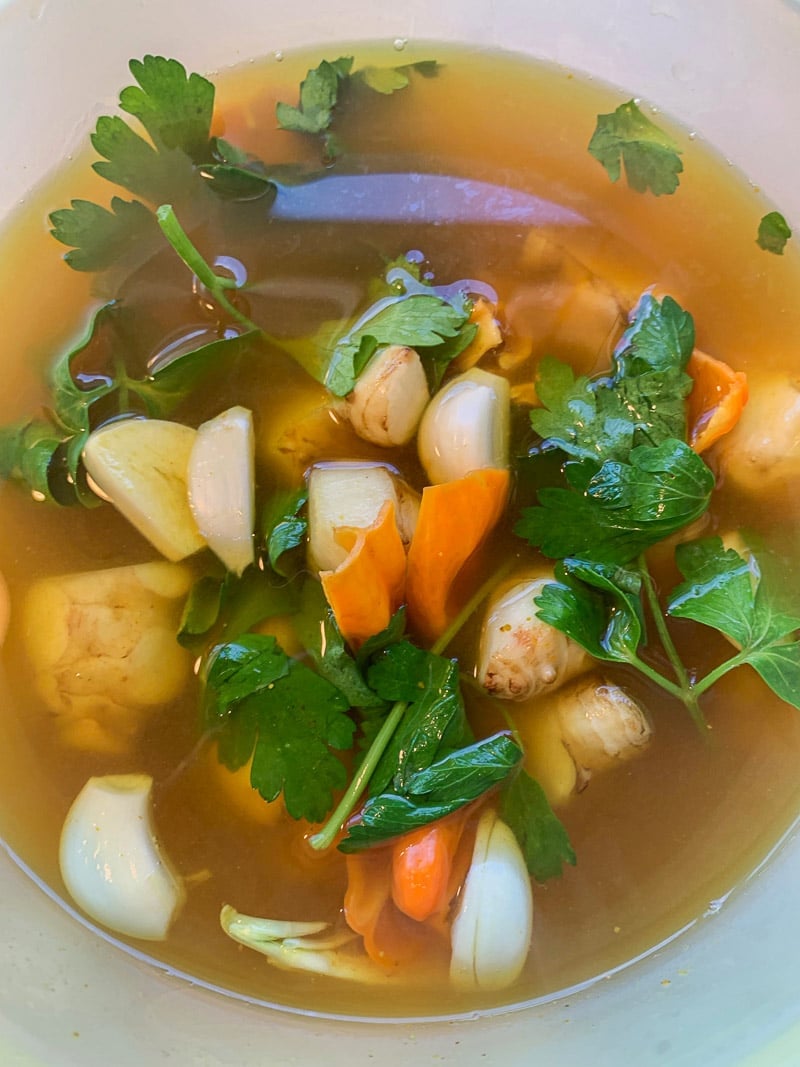
Step 9: Add the contents of the pot to sterilized jars and store in the refrigerator. Mine yielded two jars (one quart-sized jar and an eight-ounce jar).
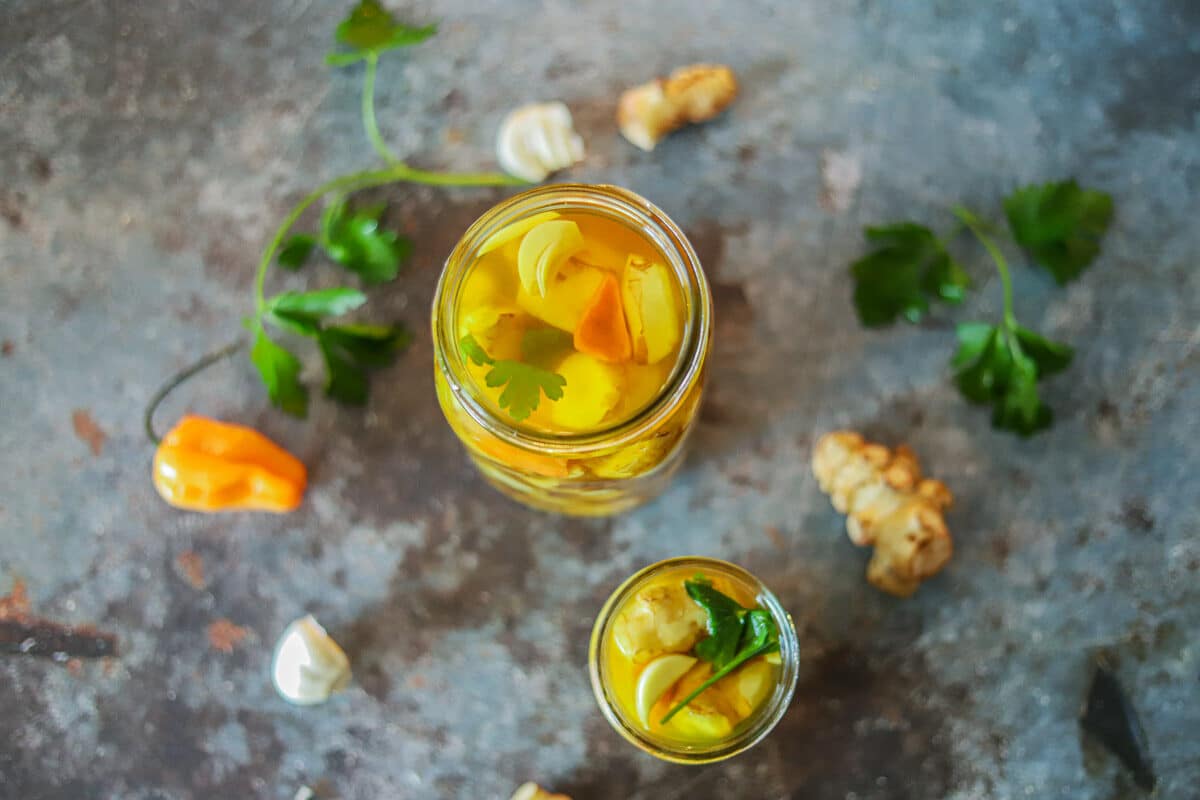
The pickled sunchokes will be ready to eat after three days but will taste better the longer they're allowed to pickle.
🤷🏻♀️ Recipe FAQs
Jerusalem artichokes are neither artichokes nor are they from Jerusalem. Sometimes they're referred to as "sunchokes."
Jerusalem artichoke is a perennial weed that can grow to be around 7' tall. A species of sunflowers, the plant has beautiful yellow flowers, 2"- 4" in diameter.
The flowers resemble sunflowers, which is why this plant and its tubers are also referred to as sunchokes. I will be using both names interchangeably in this post.
Although considered an invasive weed, the plant does have one delicious benefit; the edible tubers that grow beneath it.
Similar to potatoes in taste and texture, but sweeter, sunchokes are healthier than potatoes and lower on the glycemic index.
The 3"- 4" long tubers can be used in recipes that call for potatoes and are a great option for diabetics.
Jerusalem artichokes can be enjoyed both peeled and unpeeled. For the purpose of this pickled Jerusalem Artichokes Recipe, you can do either.
Personally, I only peel the areas that are either dark or knotty. If you plan on eating them unpeeled, be sure to scrub them thoroughly with a potato scrub brush.
Unlike potatoes, you can eat sunchokes raw. They have a crunchy texture and a mild flavor. Some people slice or julienne the sunchokes and add them to salads for added flavor and crunch.
A word of caution, however. Some people experience stomach distress and flatulence from eating raw sunchokes.
Sunchokes can also be roasted, mashed, fried, and scalloped.
In my immediate family, Jerusalem artichokes were only eaten pickled. Mom also pickled green tomatoes, eggplant, and turnips. However, pickled sunchokes have always been my favorite, probably due to their crunchy texture.
In the United States, Jerusalem artichokes usually make their appearance in a few grocery stores in late Fall or early Winter. They are harvested after the first frost.
Since they are so hard to find in stores, another option is to grow them yourself. The tubers can be purchased from catalogs.
If you can find them locally, you can try planting a few and see how it goes. Just make sure you have plenty of space to grow them because they are very invasive.
To learn more about growing your own sunchokes, check out this informative article about Growing Jerusalem Artichokes.
"Jerusalem Fartichokes" can indeed cause flatulence. This is due to the high content of inulin found in these tasty little tubers.
Gerard's Herbal, printed in 1621, quotes the English Botanist, John Goodyer, on Jerusalem artichokes:
"The inulin cannot be broken down by the human digestive system but it is metabolized by bacteria in the colon. This can cause flatulence and, in some cases, gastric pain."
When I first saw all the information on the internet regarding the flatulence-causing effects of the Sunchokes I was really surprised.
I don't remember experiencing this issue when eating pickled Jerusalem artichokes. After doing a little research on the matter it all began to make sense.
I recall mom brining the tubers in large containers after harvesting them. The liquid would become very cloudy and gaseous. It would need to be replenished with fresh brine a few times a week.
This went on for a few weeks, up to a month. Mom said that this process was necessary to release the gases from the sunchokes.
In the back of my mind, I thought this was an unnecessary step and wanted to hurry the process along, but mom didn't budge.
However, my recent research led me to the following information that validates mom's methods of preparing sunchokes:
During this pickling process, lactobacillus bacteria gorge on the inulin and convert it to gas, which manifests as bubbles in the pickling jar, rather than your intestines.
By the time the pickles are ready to eat, the inulin has already been mostly consumed, and the "bacteria farts" float away painlessly when you open the jar.
(Modern Farmer)
It turns out that this brining process, also known as lacto-fermentation, has many health benefits. This explains why foods like sauerkraut and kimchi are known for their nutritious value and their ability to aid in the restoration of gut health.
Why did I ever doubt my mom? Without knowing the fancy terminology, or the science behind it, my mom, and her mom before her, knew how to overcome the gassy effects of sunchokes. Quite impressive, don't you think?
👩🏼🍳 Pro Tips
- Never tighten the jar lid during the brining process; the bottle can burst as a result of the gases being released from the sunchokes.
- Pickled sunchokes will be ready to eat in as little as three days after pickling them in the vinegar solution. However, the longer they pickle the more flavor they will absorb.
- If you prefer canning the pickles instead of storing them in the refrigerator, be sure to pack the sunchokes in jars that have been properly sterilized. Boil sealed jars in a water bath for at least five minutes before storing them in a cool, dark location.
- If you find the pickling solution too strong, you can replace some of the vinegar with salted water. Use the ratio found in my pickled carrots recipe.
- Plastic or glass containers are perfect for storing pickles. For longer, unrefrigerated storage, use the following sterilization/canning directions.

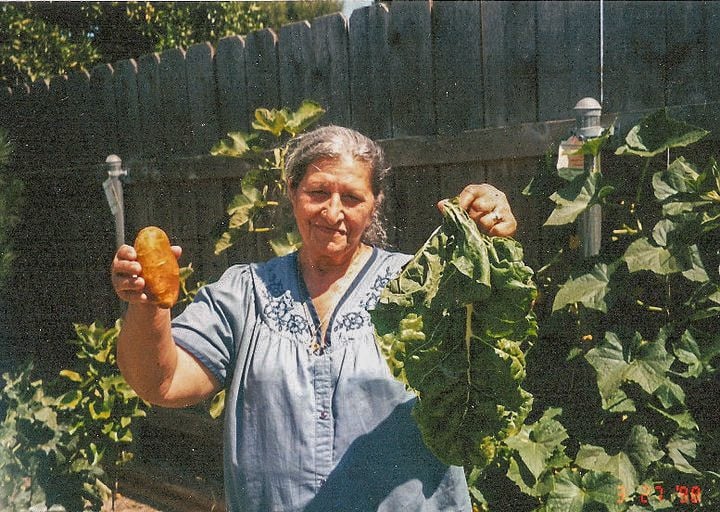
This Jerusalem artichoke recipe will forever remind me of my mom. Not only because she made the BEST pickled sunchokes. No, it's because sunchokes were partially responsible for her developing lymphedema.
Mom wasn't supposed to do anything strenuous with her arm after her lymph nodes were removed (due to breast cancer.
Unfortunately, Mom, who loved working in her garden, single-handedly pulled many sunchoke plants from their roots, so she could pickle the tubers.
Her arm swelled almost immediately, and it never went back to normal. So if you enjoy this Jerusalem artichoke recipe, give mom a little nod, would you?
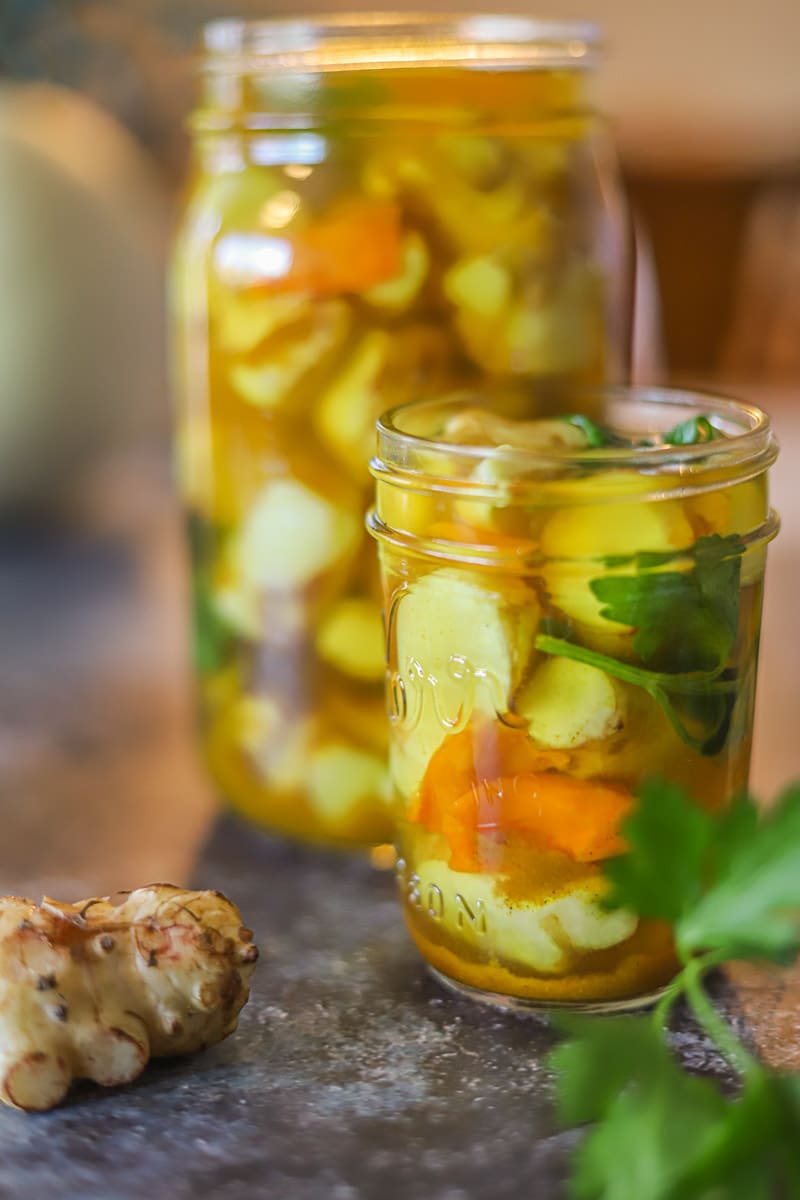
🥒 More Pickle Recipes
Did you make this recipe?
📖 Recipe
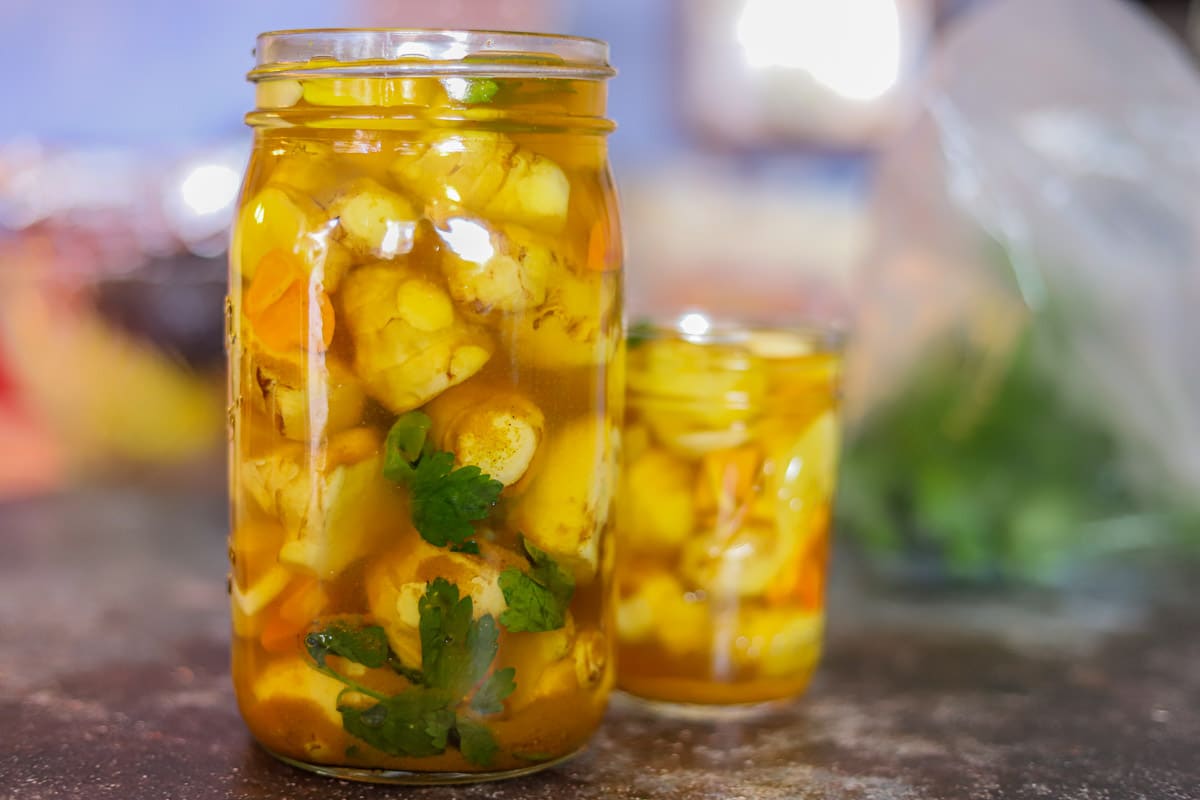
Pickled Jerusalem Artichokes
Ingredients
Equipment
Method
- Thoroughly clean Jerusalem artichokes to remove all the soil. Trim any dark spots, or knots and peel, as necessary. Cut into 1"-2" chunks
- Stir half of the salt into a quart of cold water, until dissolved. Place artichokes in a clean, sterilized jar. Cover with the brine solution. Leave the lid untightened to allow the gases to escape.
- Place the bottle in a dark location for one week. Check the bottled Jerusalme artichokes after three days.
- When the brine gets murky and gases float to the surface, drain the old brine and make a new batch using the remaining salt. Soak the artichokes in the new brine for four more days.
- Once the Jerusalem artichokes have been brining for at least one week, remove them from the brine and rinse them off with fresh, cold water.
- Place vinegar in a saucepan and bring to a boil. Remove from heat and stir curry into the vinegar until combined.
- Allow the vinegar to cool slightly, then add artichokes, garlic, parsley, and habanero pepper (if using). Add to sterilized jars and store in the refrigerator.
- The pickled artichokes will be ready to eat after three days, but will taste better the longer they're allowed to pickle.
Nutrition
Video
Notes
- Never tighten the jar lid during the brining process, the bottle can burst as a result of the gases being released from the sunchokes.
- Pickled sunchokes will be ready to eat in as little as three days after pickling them in the vinegar solution. However, the longer they pickle the more flavor they will absorb.
- If you prefer canning the pickles instead of storing them in the refrigerator, be sure to pack the sunchokes in jars that have been properly sterilized. Boil sealed jars in a water bath for at least five minutes before storing them in a cool, dark location.
- If you find the pickling solution too strong, you can replace some of the vinegar with salted water. Use the ratio found in my pickled carrots recipe.
- Plastic or glass containers are perfect for storing pickles. For longer, unrefrigerated storage, use the following sterilization/canning directions.

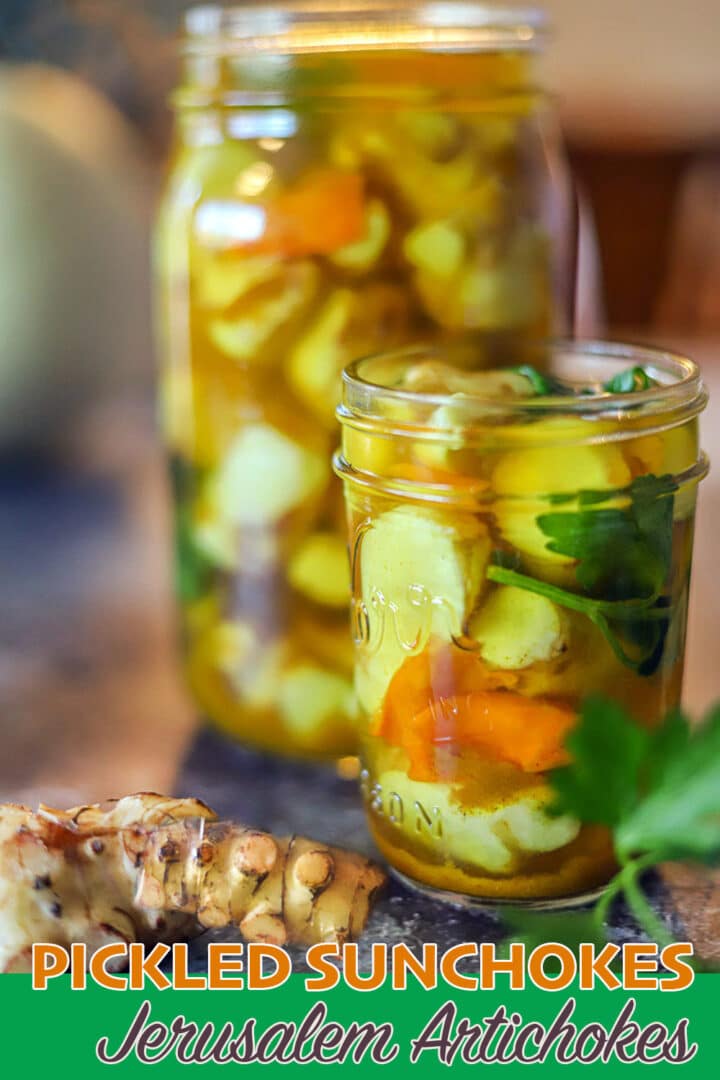

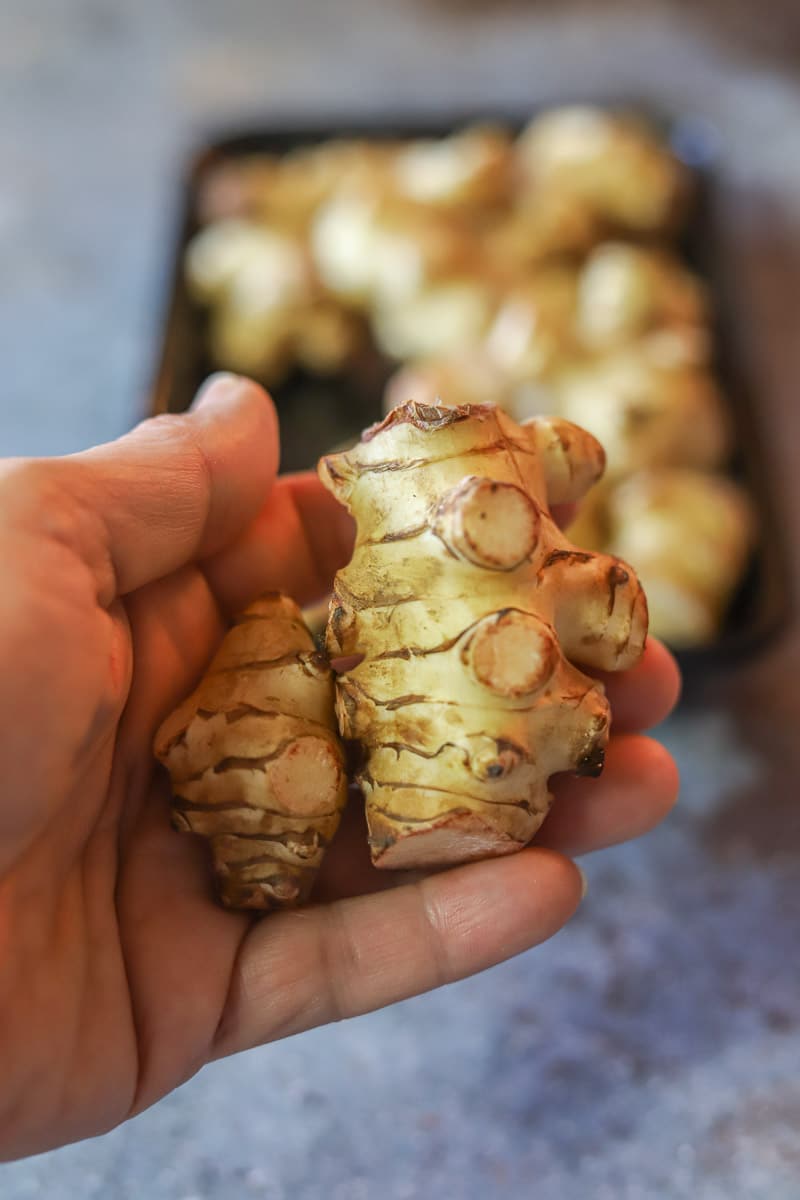

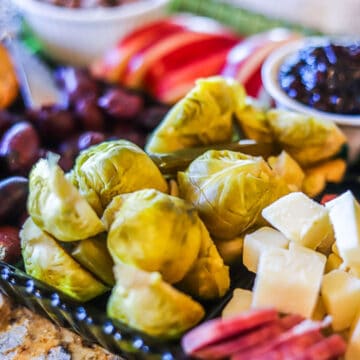
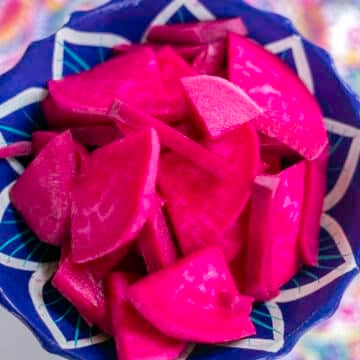
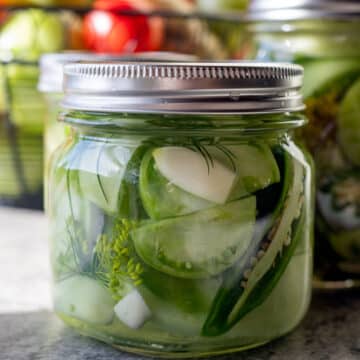
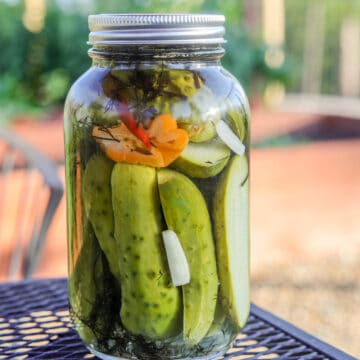
Cleda says
How long do these pickled Jerusalem Artichokes stay good in the refrigerator?
Hilda Sterner says
Hi Cleda, I've had them last 3+ months and they'd probably last longer, if they're not all eaten by then.
Jenny says
Hi,
Thank you for the recipe.
When I opened the jars after a week (when I was about to change the salt soultion to a vinegar one), I noticed that all of the jars had a layer of mold on the top.
I did change the water after 3 days, and then everything was fine. I also use sterilized jars (but I didn't sterilize them again when changing rhe salt solution).
Why did this happen? should I just throw everything away?
Hilda Sterner says
Ugh, that’s the worst! It usually means something wasn’t fully submerged or a little air (or bacteria) snuck in when you changed the brine.
Next time, make sure everything stays under the liquid and re-sterilize your jars before swapping the brine. Murkiness is normal, but you mention mold? Can you email me a pic? Maybe we can discuss it further once I see what you are referring to.
Steven Gunderson says
Thank you for this great recipe Hilda. I am growing sun chokes this year and I found your recipe. It looks delicious and I will make this in honor of your beautiful mother. I can't wait to try it. Thanks again.
Hilda Sterner says
Thank you so much Steven, hope you come back and rate the recipe. Good luck!
Kelly Methey says
These are so interesting to me. I had never tried them before. They are crunchy, spicy and tart all at once, a great combination. They have a very unique flavor with the curry and vinegar. Thank you Hilda for introducing me to another tasty treat!
Hilda Sterner says
They are definitely interesting! I know not too many people know about them so I like to spread the word!
Teresa Evers says
Hilda, I enjoyed your Jerusalem artichokes. They were very spicy, which I like. I will enjoy as a side dish with appetizers or maybe a sandwich. I like the fact that is also a good healthy bacteria for the stomach.
Hilda Sterner says
Thank you for the review. I can't stop eating my jar and will be bummed when they're done because I know I have to wait another year for the next crop!
Paul says
It disappoints me that a fridge is required, after fermentation. It just doesn't feel right.
Hilda Sterner says
Hi Paul, Growing up, we always kept them in the fridge. That is to say, I've never tried not refrigerating them, just doing what I was taught, but they'd probably be fine unrefrigerated. 🤷🏻♀️